Summit Stories: Lessons in Simplicity and Strength on Kilimanjaro
Key Points
-
Bringing elements of the outdoors into learning spaces is a great way to keep learning engaging, and effective for students.
-
Nature is one of the greatest teachers of all, it is important that we learn from it!
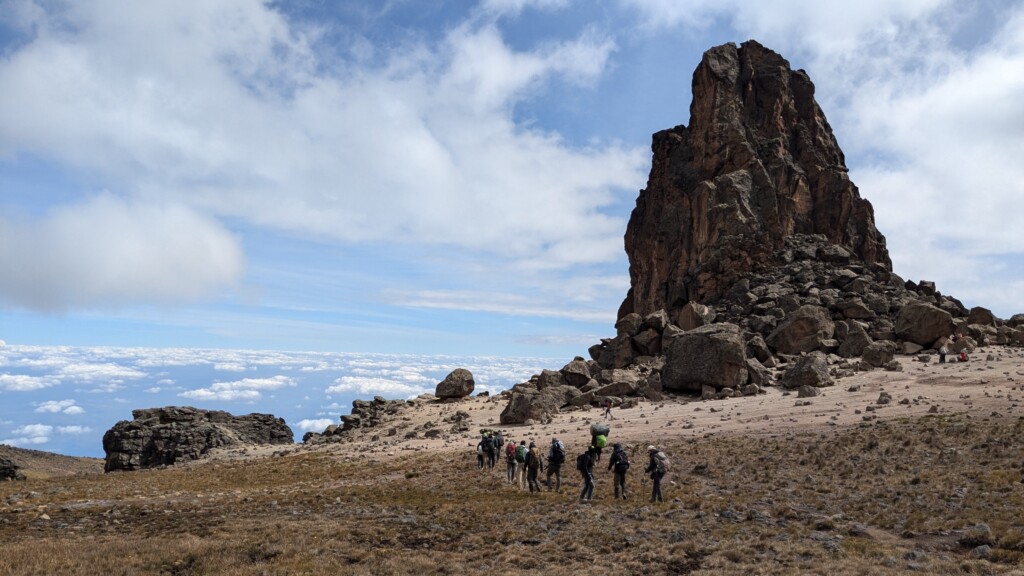
Summer is waning. Have you yet had the luxury to truly and entirely dedicate yourself to any one thing? If so, did you have the space to do so for eight consecutive days? I was fortunate to have the space. The focus was climbing to the roof of the African continent. A lot was learned along the way. A reminder of the power of song, teamwork, and the importance of listening to leadership. However, most enduring is the lesson learned on the beauty of simplicity.
One Team, One Dream: The Power of Unity and Song
We elected to take the 8-day route up the mountain. This provided the opportunity to cross through five distinct climatic zones. On day seven we would be climbing at midnight, up and across talus and scree fields. More vertical than before, the ascent would begin after a few attempted evening hours of sleep at over 15,000’. Like most higher camps, tents at Barafu High Camp, our base camp, are pitched on unlevel ground and I would find myself a huddled mass at the bottom of my tent. Having slid all the way down, often I would awake wondering if there might be some way to strategically clip a D-ring to connect my sleeping pad to the tent in order to stay in place.
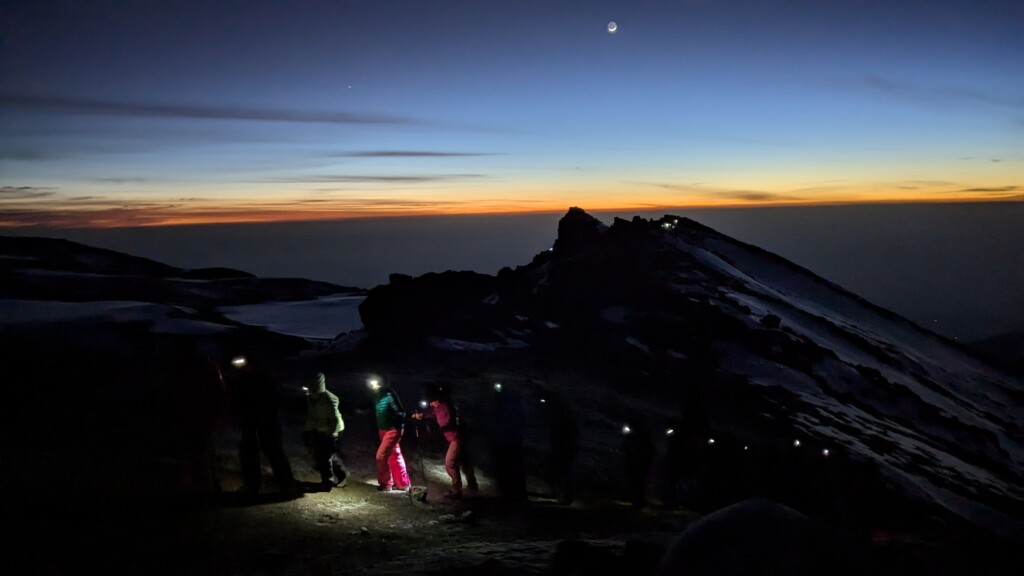
The night was dark, days prior was the new moon, and the entire way up was lit by little torches. We would pause approximately every hour, a time kept at short intervals so as not to freeze. The guides would adamantly advise, “Do not sleep!” The higher up one goes, the less oxygen and feeling sleepy is one of several symptoms of altitude sickness, a not so uncommon occurrence when a person travels above 8,000 feet. I was one of two trip leaders in a group with 13 gung-ho teens who similarly shared a sort of mantra. Ari, our lead guide, periodically called it out, “One team, one dream. To the top, non-stop.” Though bleary-eyed, sleep deprived, with headache, and freezing cold, everyone was likely wondering if we would ever reach the peak. Five hours gone by and the sun was still not on the horizon. The summit remained invisible. Morale was between low and dormant. Yet, Ari continued to call out and we echoed, “One team, one dream. To the top, non-stop.”
Our call and response were surprisingly not the only sounds to be heard on the mountain. For much of the way, a team behind us sang one song after another, the entire way up. Every twenty minutes or so, their songs recycled. The most memorable was a sort of classic, one we were introduced to during our first days in Tanzania. It is called, “Jambo Bwana.” The first verse goes:
Jambo! Jambo bwana! (Hello!, Hello sir!)
Habari gani? Mzuri sana! (How are you? Very well!)
Wageni, mwakaribishwa! (Guests, you are welcome!)
Kilimanjaro? Hakuna matata! (Kilimanjaro? No trouble!)
The exclamation marks are fitting additions as Kilimanjaro is a mountain of superlatives. The song shares optimism, encouraging to walk “pole pole” (slowly) and to drink plenty of water. Hakuna matata, hakuna matata, hakuna matata (No trouble, no trouble, no trouble). The reason for the song was not frivolity as science proves how singing is one way to release endorphins. The voices resonating behind us were filled with morale. The song possibly distracted their minds and added to having a good time. Or so they seemed to be having a good time! We all chose this experience after all, and a focus on fun is so important when you otherwise might feel like being part of a death march.
So, might we be wise to intentionally bring a little song into our schools and classrooms?
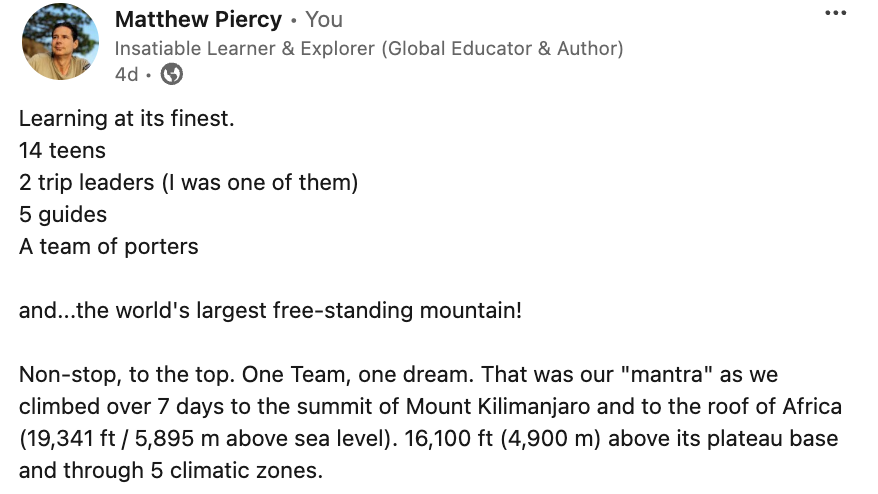
Teamwork: Dependence Upon the Unsung Heroes
Education like most institutions and industries finds itself in transition. Many of us are gassed, short of breath, and possibly are unable to see the mountain top. How critical it is then that we trust. In ourselves, what is true and what is possible. Staying the course is essential. As is conditioning. To prepare for Kilimanjaro, I did what I considered to be the best elevation training I could. Trekking six miles from 9,200’ to 13,803’. In retrospect, better training would have had me start from sea level! Warren Hollinger is an example of the sort of tenacity required to push through times of transition. His sea-to-summit adventure on this same mountain covered 54 miles and over 14,000 feet of elevation gain. A lesson on perseverance and strength and yet it does not exactly rival the feats of skyrunner, Karl Egloff. On average, most trekkers take 6 days to ascend Kilimanjaro, but Egloff reached the summit in an unconscionable record-breaking time of 4 hours and 56 minutes. Over 13,000 feet of elevation gain!
Hollinger and Egloff’s superhuman solo feats are fantastic, yet we would be remiss if we were to overlook the importance of teamwork. For none of us is going about education alone.
Our trip up Kilimanjaro epitomized teamwork. We depended on a team of guides and a legion of porters. One student asked in an off-the-cuff conversation, “Matt, how much would you charge us if you were our porter?” Before I could even fathom an amount, another student half whimsically intercepted the exchange, saying frankly “If you could even do it, Matt.” She was right, I don’t think I could do it. Porters, the unsung heroes, not only carried personal gear and our packs but all of the group gear (mess tent, food, fuel, tents, etc.). In effect, approximately 60-70lbs. Some of them humbly recounted having been to the mountaintop more than 200 times and one porter on our team was 64 years old! The lesson is one of utmost respect for our porters but also a greater understanding of how we always are part of something greater than just ourselves and are not alone. Even if our classrooms or schools may at times feel like islands, we are a collective.
Leadership and Vital Lessons Learned from the Climb
One student in particular, we’ll call her “T” ended up possibly being our greatest teacher. To say she reluctantly listened to the guides is an understatement. Instead, she consistently defied their guidance. Obstinate, her choices led to ill health, a negative impact on the group, and a definitive strain on resources. T’s stubbornness was first noted when she refused to join the group. Even with a clear invitation from us and peers, she would stand on the side and partially pay attention. When it came time to revise what she packed in preparation for the “expedition” she had a windbreaker for a jacket, no gloves, a blanket as opposed to a sleeping bag, and no sleeping pad. All told, seven fellow students came to the rescue and lent her the necessary gear. The guides probably reiterated the importance of hydration close to 200 times. A minimum of three liters of water a day was the expectation. Yet, T was determined to do what she wanted, drinking less than ½ a liter even with constant probing. Claiming a very strict diet T also either did not eat or selected just white rice. The result was a little engine that simply could not. Four porters ended up coming off the mountain with T. Again, this was a lesson of what not to do and we all understand even better the importance of listening to those who have come before us, our guides.
From Mountains to Classrooms: Simplicity in Action
“Nature is pleased with simplicity”. (Sir Isaac Newton)
Life in nature has a way of radically simplifying things. We rose with the sun and crawled into our tents when the night skies turned on. Other than our dependence on porters and the value of listening to our guides, any complexity to life was stripped down.Such simplicity was refreshing.
Could such simplicity be translated to learning? To our classrooms? Moreover, what about our education systems? What might this look like?
For a few weeks, I considered this. As an example, for a course I teach on entrepreneurship it might all be boiled down to three competencies:
- Communicate and empathize with people who have perspectives and experiences different from your own.
- Curate and create content relevant to real-world issues.
- Reflect on and take responsibility for your learning and that of others.
This ultimately is what I endeavor for students to walk away having learned. Within each competency, there are a few expected outcomes. Further, there are many activities and assessments. However, the focus is on just three competencies. The result of such simplicity is clarity for students. Such a winnowing down of competencies helps to inform the student experience. The competencies are like hydration on the trek up Kilimanjaro, something we drink daily as students have ample opportunity to practice. With this practice and feedback, students move toward mastery.
Maybe we even sing along the way.
Jambo! Jambo bwana! (Hello!, Hello sir!)
Habari gani? Mzuri sana! (How are you? Very well!)
The power of song, teamwork, listening to leaders, and the beauty of simplicity. Though there is much to consider, hopefully, there is at least one transferable idea.
See you on the mountaintop!
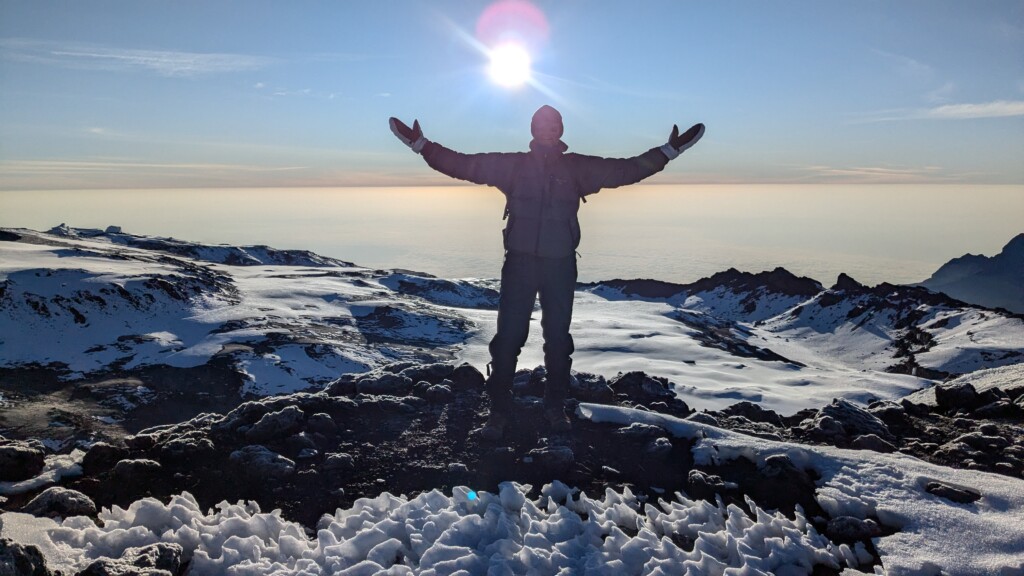
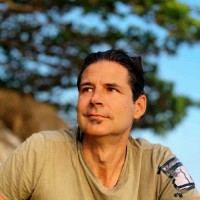




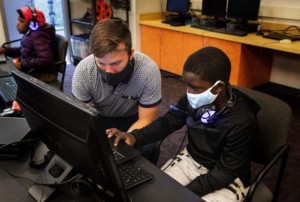

0 Comments
Leave a Comment
Your email address will not be published. All fields are required.